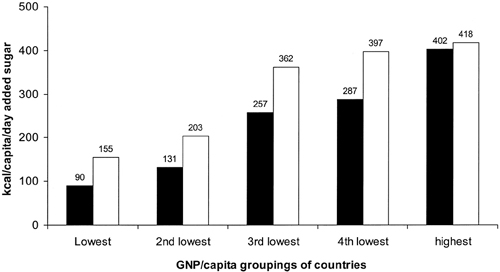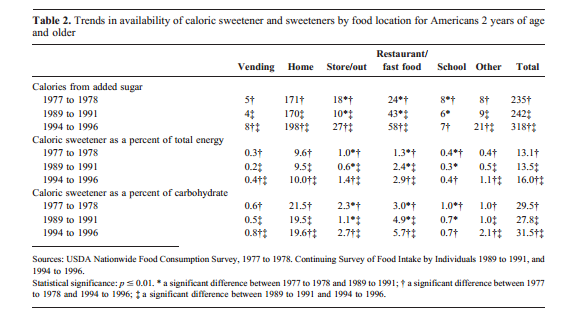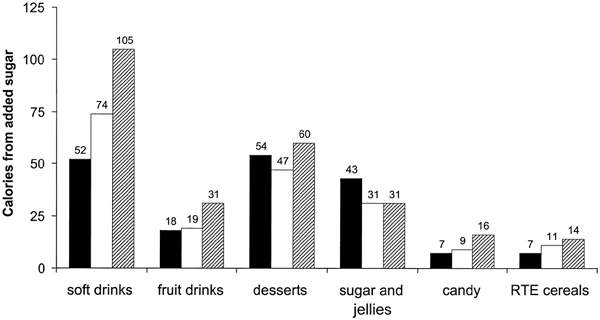The world is becoming a sweeter place… At least in a very literal sense. In The Sweetening of the World’s Diet, Popkin and Nielsen explore the upward trend of caloric sweeteners in our lives.
The article first lays out some very basic evidence:
- High consumption of sugar-sweetened beverages has been linked with increased energy intake and obesity.
- Cancer researchers have voiced concerns over the reduced intake of more complex carbohydrates and high fiber foods and replacement of these food sources with refined carbohydrates.
- Milk has been increasingly substituted with soft drinks.
- A long term study found that overweight subjects who consumed large amounts of caloric-sweetened beverages increased energy intake, body weight, fat mass, and blood pressure after a 10 week intervention. This was not observed in a similar group receiving artificial sweeteners.
- Calories from fluids are less sating that those from solid foods and often lead to overconsumption.
The authors then carefully state they are not attempting to prove sugar makes you fat. Instead, they assert that they are just here to examine the history.
So what of this history? Well, they find an ~82% change in caloric sweetener intake can be attributed to Gross National Product (GNP) and urbanization of the country. In this figure you can see the greatest leaps in consumption of sugar for the lower and middle income countries. (Solid bars, 1962, and open bars, 2000.)
In the US between 1977 and 1996, urbanization increased from 74% to 76%, while GNP per capita went from 19,930 to 28,350. During this time, caloric sweetener consumption increased by 83 kcal for everyone. Of the total increase of 83kcal, 54 come form soft drinks, 13 from sugared fruit drinks.
This graph shows the shift in food sources of caloric sweetener in the US. (Solid bars 1977-8, open bars 1989-91, hatched bars 1994-96.)
This isn’t in the paper but in case you forgot here’s a lovely graph from the CDC (source):
Why is urbanization linked to higher sugar consumption? Is sugar consumption causing obesity? One thing is for sure, the authors find a way to out-vague most politicians with their answers.
Urbanization is correlated highly in the developing world with access to processed foods higher in sugar. Urbanization is also linked with greater access to modern mass media, better transportation systems, and larger modern supermarkets. […] increases in income also play a powerful separate role in food consumption decisions, in particular, decisions related to the consumption of more processed foods.
O… Okay?
When the results of this study are coupled with earlier studies, we can clearly see a pronounced shift in the world’s diet toward increased consumption of caloric sweetener and away from higher-fiber foods.
Alright now we’re getting somewhere!
Because of limited research, the implications of these dietary shifts on human health are unclear, and there is still little understanding of replacement issues. It is clear, however, that consuming excessive soft drinks or other high-sugar, low-nutrient foods will either add calories or reduce nutrient intakes. The issue of caloric sweetener and its potential effects on obesity and other metabolic disorders is not yet fully understood or accepted.
Vagueness level: mud.
Other research by Ludwig and others point out that the effect of refined sugar intake on glycemic response represents a potentially important negative health effect of caloric sweetener. Among the conclusions from research are that sugar has a very high glycemic index and that consumption of higher caloric sweetener foods and beverages is related to increased dietary intake and other metabolic complications. Excessive added sugar intake may contribute to obesity.
Ah hah, finally a hypothesis! Only took an entire research paper to get to this point. Now on to my favorite quote:
In contrast, many representatives of the food industry maintain that sugar in food and caloric sweetener may have neutral effects on health. This viewpoint is often expressed during forums, most often sponsored by the International Life Sciences Institute.
You sly dogs, Popkin and Nielsen.

Resources
- The Sweetening of the World’s Diet, Popkin, B. M. and Nielsen, S. J. (2003). Obesity Research, 11: 1325–1332. doi: 10.1038/oby.2003.179
- Prevalence of Overweight, Obesity, and Extreme Obesity Among
Adults: United States, Trends 1960–1962 Through 2007–2008, Ogden and Carroll, CDC – Division of Health and Nutrition Examination Surveys. June, 2010.





As always, a great posting, we really enjoyed the insightful asides!
In regards to artificial sweeteners: People on low-carb or keto diets must know that artificial sweeteners cannot be depended on to provide a harmless sugar-fix. The blood glucose value is such a critical quantity that the pancreas routinely has a large supply of proinsulin ready to be dumped into the blood stream at the first hint that glucose is on its way. That first hint happens to be a sweet taste in the mouth. Excess blood glucose is too dangerous a matter to wait for digestion and absorption of sugars to occur.
Artificial sweetness and natual sweetness cannot be distinguished from one another by the mouth. Therefore, artificial sweeteners, like sugar, stimulate the quick release of proinsulin/insulin, except there is no glucose to deal with. We are not aware of any studies on the adverse effects of this unnecessary release of insulin other than that artificial sweeteners do cause the same obesity effects as those produced by sugar.
From the point of view of biochemistry, we would expect that high insulin levels caused by either sugar or artificial sweeteners would stimulate the D5D enzyme. When stimulated, this enzyme increases the conversion of arachidonic acid to pro-inflammatory eicosanoids. This, in turn, increases the risk of all of the chronic debilitating diseases.
Here are some references from MND 2002:
And more recent references from on line: